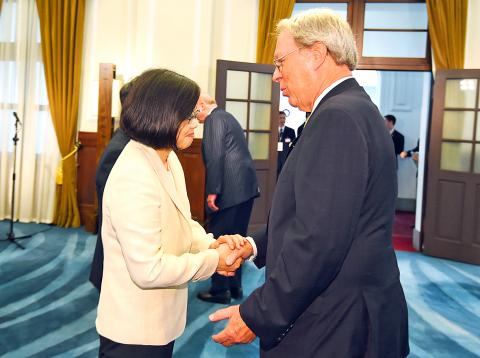The term “1992 consensus” was non-existent until 2000, when then-Mainland Affairs Commission chairman Su Chi (蘇起) first used it, American Institute in Taiwan (AIT) Chairman Raymond Burghardt said.
Burghardt made the remarks in an interview with Voice of America in Washington on Wednesday when he was asked about the historical background of the so-called “1992 consensus,” as he was formerly the US consul-general in Shanghai.
“I think everyone in China knows, the term ‘1992 consensus’ was not used by anyone until 2001, no, 2000; Su Chi, [former] president Ma Jing-jeou’s [馬英九] first National Security Council adviser, was the first person to use that term to describe the understanding that had been reached in 1992. Before that, I mean, in all the time I met with [then-Association for Relations Across the Taiwan Straits (ARATS) chairman] Wang Daohan (汪道涵) or with [then-Straits Exchange Foundation (SEF) chairman] Koo Chen-fu (辜振甫), they never called it that, never called it the ‘1992 consensus,’ because the name didn’t exist. Koo would sometimes just call it the ‘1992 understanding,’” he said.

Photo provided by Taipei Photojournalists Association
The “1992 consensus” refers to a tacit understanding between the two sides of the Taiwan Strait that there is “one China,” with each side having its own interpretation of what “China” means.
In 2006, Su, then a Chinese Nationalist Party (KMT) legislator, admitted he made up the term “1992 consensus” in 2000, before the KMT handed power to the Democratic Progressive Party.
Meanwhile, responding to the question of whether President Tsai Ing-wen (蔡英文) was muddying the water when she did not explicitly recognize or deny the “1992 consensus” or the “one China” principle in her inauguration address, Burghardt said Tsai has displayed flexibility in dealing with cross-strait relations and it is important for both China and Taiwan to continue to communicate.
He also said it is important for both sides to “create a certain amount of ambiguity,” adding that there was a lot of ambiguity in the understanding reached between the Ma administration and China.
Burghardt said this is an important period for both Beijing and Taipei to carefully watch each other’s actions and statements.
However, he also said it is very important for both sides to “keep an open mind” and maintain communication.
Burghardt said that one of the things the US prized very much after Ma took office in May 2008 was the “restoration of regular communication across the Strait.”
He said that if both sides can talk to each other, miscommunication, misunderstanding and miscalculation “can all be avoided.”
Asked whether cross-strait relations are not as warm as during the Ma administration, Burghardt said that “it is unfortunate that Beijing decided to discontinue or suspend talks” between the two sides recently.
He expressed hope that Beijing can understand the importance of cross-strait communication and will want to continue, as “nothing is going to be fixed without continued communication.”

The US government has signed defense cooperation agreements with Japan and the Philippines to boost the deterrence capabilities of countries in the first island chain, a report by the National Security Bureau (NSB) showed. The main countries on the first island chain include the two nations and Taiwan. The bureau is to present the report at a meeting of the legislature’s Foreign Affairs and National Defense Committee tomorrow. The US military has deployed Typhon missile systems to Japan’s Yamaguchi Prefecture and Zambales province in the Philippines during their joint military exercises. It has also installed NMESIS anti-ship systems in Japan’s Okinawa

TRAGEDY STRIKES TAIPEI: The suspect died after falling off a building after he threw smoke grenades into Taipei Main Station and went on a killing spree in Zhongshan A 27-year-old suspect allegedly threw smoke grenades in Taipei Main Station and then proceeded to Zhongshan MRT Station in a random killing spree that resulted in the death of the suspect and two other civilians, and seven injured, including one in critical condition, as of press time last night. The suspect, identified as a man surnamed Chang Wen (張文), allegedly began the attack at Taipei Main Station, the Taipei Fire Department said, adding that it received a report at 5:24pm that smoke grenades had been thrown in the station. One man in his 50s was rushed to hospital after a cardiac arrest

‘WIN-WIN’: The Philippines, and central and eastern European countries are important potential drone cooperation partners, Minister of Foreign Affairs Lin Chia-lung said Minister of Foreign Affairs Lin Chia-lung (林佳龍) in an interview published yesterday confirmed that there are joint ventures between Taiwan and Poland in the drone industry. Lin made the remark in an exclusive interview with the Chinese-language Liberty Times (the Taipei Times’ sister paper). The government-backed Taiwan Excellence Drone International Business Opportunities Alliance and the Polish Chamber of Unmanned Systems on Wednesday last week signed a memorandum of understanding in Poland to develop a “non-China” supply chain for drones and work together on key technologies. Asked if Taiwan prioritized Poland among central and eastern European countries in drone collaboration, Lin

ON ALERT: Taiwan’s partners would issue warnings if China attempted to use Interpol to target Taiwanese, and the global body has mechanisms to prevent it, an official said China has stationed two to four people specializing in Taiwan affairs at its embassies in several democratic countries to monitor and harass Taiwanese, actions that the host nations would not tolerate, National Security Bureau (NSB) Director-General Tsai Ming-yen (蔡明彥) said yesterday. Tsai made the comments at a meeting of the legislature’s Foreign Affairs and National Defense Committee, which asked him and Minister of National Defense Wellington Koo (顧立雄) to report on potential conflicts in the Taiwan Strait and military preparedness. Democratic Progressive Party (DPP) Legislator Michelle Lin (林楚茵) expressed concern that Beijing has posted personnel from China’s Taiwan Affairs Office to its